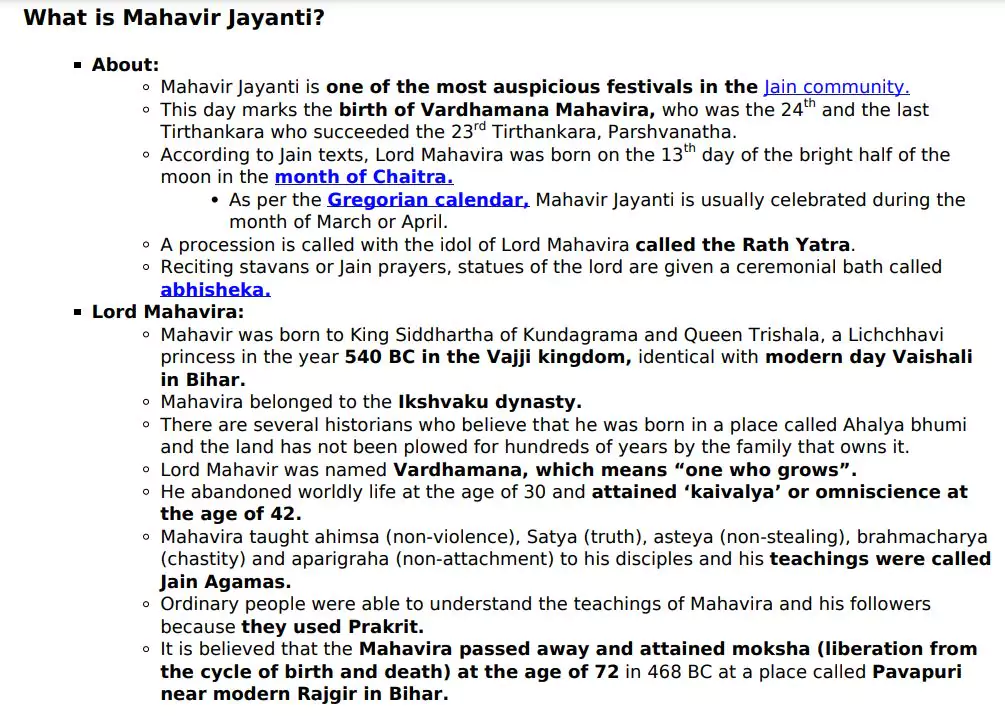‘महावीर जयंती’ PDF Quick download link is given at the bottom of this article. You can see the PDF demo, size of the PDF, page numbers, and direct download Free PDF of ‘Mahavir Jayanti’ using the download button.
महावीर जयंती – Mahavir Jayanti PDF Free Download

Mahavir Jayanti
What is Mahavir Jayanti?
About:
Mahavir Jayanti is one of the most auspicious festivals in the Jain community.
This day marks the birth of Vardhamana Mahavira, who was the 24th and the last Tirthankara who succeeded the 23rd Tirthankara, Parshvanatha.
According to Jain texts, Lord Mahavira was born on the 13th day of the bright half of the moon in the month of Chaitra.
As per the Gregorian calendar, Mahavir Jayanti is usually celebrated during the month of March or April.
A procession is called with the idol of Lord Mahavira called the Rath Yatra.
Reciting staves or Jain prayers, statues of the lord are given a ceremonial bath called abhisheka.
Lord Mahavira:
Mahavir was born to King Siddhartha of Kundagrama and Queen Trishala, a Lichchhavi princess in the year 540 BC in the Vajji kingdom, identical with modern-day Vaishali in Bihar.
Mahavira belonged to the Ikshvaku dynasty. There are several historians who believe that he was born in a place called Ahalya bhumi and the land has not been plowed for hundreds of years by the family that owns it.
Lord Mahavir was named Vardhamana, which means “one who grows”.
He abandoned worldly life at the age of 30 and attained ‘kaivalya’ or omniscience at the age of 42.
Mahavira taught ahimsa (non-violence), Satya (truth), asteya (non-stealing), brahmacharya (chastity) and aparigraha (non-attachment) to his disciples and his teachings were called Jain Agamas.
Ordinary people were able to understand the teachings of Mahavira and his followers because they used Prakrit.
It is believed that the Mahavira passed away and attained moksha (liberation from the cycle of birth and death) at the age of 72 in 468 BC at a place called Pavapuri near modern Rajgir in Bihar.
What is Jainism?
The word Jaina comes from the term Jina, meaning conqueror.
Tirthankara is a Sanskrit word meaning ‘Ford maker’, i.e., one who is able to ford the river, to cross beyond the perpetual flow of earthly life.
Jainism attaches utmost importance to ahimsa or non-violence.
It preaches 5 mahavratas (the 5 great vows):
Ahimsa (Non-violence)
Satya (Truth)
Asteya or Acharya (Non-stealing)
Aparigraha (Non-attachment/Non-possession)
Brahmacharya (Celibacy/Chastity)
Among these 5 teachings, the Brahmacharya (Celibacy/Chastity) was added by Mahavira.
The three jewels or Triratna of Jainism include:
Samyak Darshana (right faith).
Samyak Gyana (right knowledge).
Samyak Charitra (right conduct).
Jainism is a religion of self-help.
There are no gods or spiritual beings that will help human beings.
It does not condemn the varna system.
In later times, it got divided into two sects:
Shvetambaras (white-clad) under Sthalabahu.
Digambaras (sky-clad) under the leadership of Bhadrabahu.
The important idea in Jainism is that the entire world is animated: even stones, rocks, and water have life.
Non-injury to living beings, especially to humans, animals, plants, and insects, is central to Jaina
philosophy.
According to Jain’s teachings, the cycle of birth and rebirth is shaped through karma.
Asceticism and penance are required to free oneself from the cycle of karma and achieve the liberation of the soul.
The practice of Santhara is also a part of Jainism.
It is the ritual of fasting until death. Swetambara Jains call it Santhara whereas Digambars
call it Sallekhana.
| लेखक | – |
| भाषा | हिन्दी |
| कुल पृष्ठ | 3 |
| PDF साइज़ | 1 MB |
| Category | Religious |
| Source/Credits | jainfoundation.in |
Download English PDF Of Mahavir Jayanti, Click Here
महावीर जयंती – Mahavir Jayanti PDF Free Download
